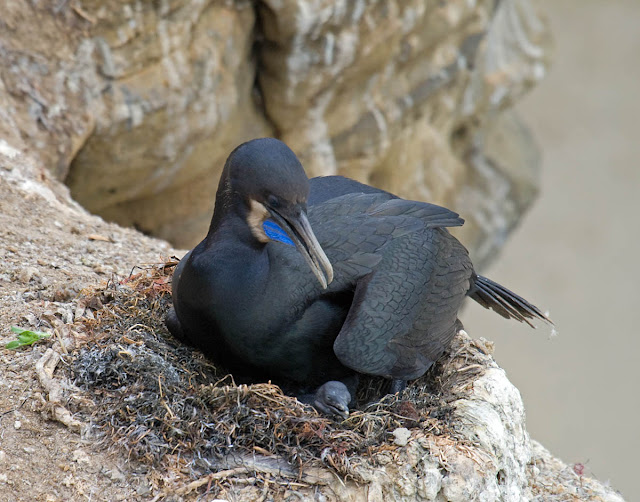At La Jolla Cove the cormorants were nesting on the cliffs right below the walkway. Several people were taking photos and many more were stopping to watch the antics. One particular nest was receiving a lot of attention as the just-hatched chicks were peeking out from under the parent.
 |
| Brandt's Cormorant and chick. La Jolla, California. May 1, 2016. Greg Gillson. |
Brant's Cormorants have a pale patch of feathers on the throat. In the spring the featherless throat pouch turns a brilliant blue. The breeding display consists of flipping the head backwards over its back and ululating with fluttering throat pouch displayed to the sky.
A couple of Double-crested Cormorants were also on the cliffs. They have a yellow-orange throat pouch throughout the year. As you can see by the photo below, the high breeding plumage brings a tuft of white feathers back from the eye. These are the "crests" mentioned in the name. Interestingly, these crests are white in Western birds, but black and larger in other populations across North America. Double-crested Cormorants are found in marine and fresh water across the continent, while other cormorants in North America are primarily restricted to salt water habitats. Notice that the eye is circled by blue--it's actually the eyelids in breeding plumage!
 |
| Double-crested Cormorant. La Jolla, California. May 1, 2016. Greg Gillson. |
I love the coppery pattern on the back and wing coverts that birds, such as the one above, show in fresh plumage. As the feathers wear they lose their shine and appear dull blackish-brown.




Amazing. I love san diego and my friend just took a picture of the sea lions with some of these so i asked her what they were. she is hearing-impaired so she calls them COMORANS they are cute
ReplyDeleteThank you for your nice comments. San Diego is a pretty nice place to live for the sun, scenery, and birds!
Delete